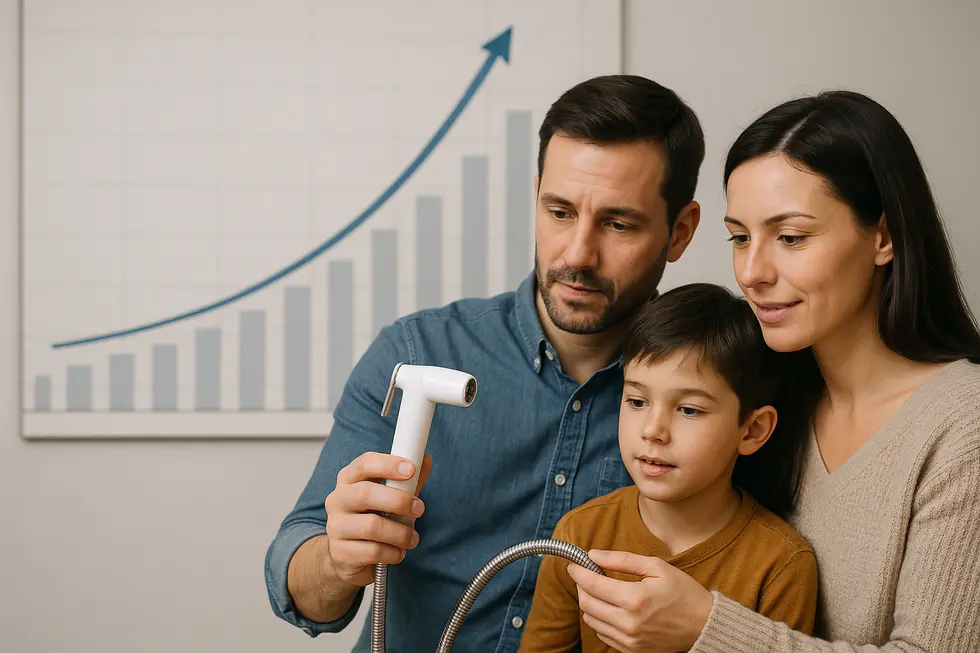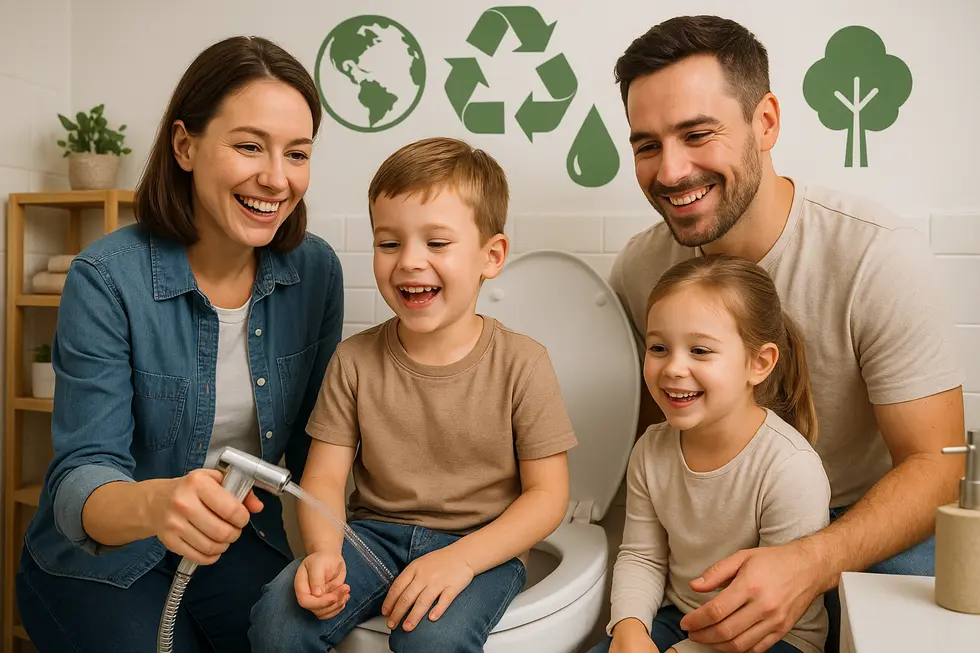Portable Bidet
Portable Bidet Sprayers: A Cleaner Solution for Families
Portable bidet sprayer solutions are increasingly becoming a must-have for families seeking hygienic and eco-friendly alternatives to traditional toilet paper. These devices offer not only improved personal cleanliness but also environmental advantages by reducing paper waste. Our journey begins with an exploration of the latest technological innovations that make these sprayers efficient and user-friendly. We’ll then delve into the economic drivers and market dynamics fueling their adoption. Finally, we’ll examine the societal and environmental impacts of using portable bidet sprayers, highlighting their benefits for both families and the planet.
Micro-Motors, Warm Water, and Smart Angles: The Technology Powering Modern Portable Bidet Sprayers

The first generation of squeeze-bottle bidets proved that hygiene could travel. Today’s models build on that legacy by hiding serious engineering inside palm-sized housings. At the heart of many premium portables is a micro brushless motor no wider than a coin. These motors spin quietly, maintain steady pressure, and sip power, which means a single charge or two tiny batteries can fuel days on the road. Because the pump is so small, designers can dedicate more interior space to the water reservoir without enlarging the overall footprint.
Miniaturisation alone, however, does not guarantee comfort. Engineers have therefore focused on ergonomic spray control. Nozzles now swivel through multiple angles, letting users find the perfect trajectory without contorting wrists or removing a toilet seat. Some mechanisms employ an EZ-Lift arm: a simple lever that lifts the nozzle clear of the housing for deep self-cleaning, then snaps back into place, avoiding bacterial build-up while keeping moving parts protected during transit.
Another leap forward is the integration of on-demand warm water. Compact heaters paired with thermal sensors raise room-temperature water to a soothing 37–40 °C in seconds. Importantly, these circuits are sealed away from the pump, so accidental splashes never reach electrical components. Warm water expands the audience for portables, attracting users who previously associated travel bidets with chilly discomfort.
Material science plays a supporting role. Food-grade silicone bellows, antimicrobial ABS plastics, and replaceable charcoal filters keep the interior fresh. Combined with one-way intake valves, they prevent backflow and cross-contamination, an essential upgrade for campers filling their sprayer from unpredictable sources.
For travellers comparing options, it is worth noting how far design philosophies have diverged. Some brands champion ultra-light manual bottles; others fold motors, heaters, and adjustable heads into a unit scarcely larger. A brief scan of recent reviews of handheld travel bidets illustrates the variety now available.
From Luxury to Everyday Essential: The Economics Driving Portable Bidet Sprayer Popularity

Portable bidet sprayers have shifted from niche novelty to mainstream purchase thanks to an unusually harmonious mix of price, practicality, and wider social trends. At roughly $40–$120, they sit well below the triple-digit tags attached to full bidet seats or integrated smart toilets, inviting first-time users to experiment without financial anxiety. Because most models are self-contained bottles or battery units, installation is usually nothing more than filling the reservoir or attaching a small hose—no plumbers, no permits, and therefore no hidden costs. This do-it-yourself simplicity is crucial in a market where even a modest service call can erase the savings of a lower-priced product.
Affordability alone, however, doesn’t guarantee adoption. What truly accelerates sales is the alignment with post-pandemic hygiene consciousness. Consumers who once stocked mountains of toilet paper discovered its logistical and ecological limits; a portable sprayer solves both issues in one purchase. By cutting paper consumption, families can recoup the initial outlay in a few months, turning the sprayer into a budgetary win as well as an environmental statement. That sustainability angle resonates especially with younger buyers, a demographic already comfortable adding reusable bottles and metal straws to everyday carry. Their enthusiasm spills over into social channels, creating word-of-mouth momentum traditional advertising struggles to match.
Demographics further expand the market. Aging populations appreciate a gentle water rinse that reduces the physical strain of wiping, while campers and frequent travelers value the independence from fixed plumbing. These overlapping use-cases mean manufacturers aren’t chasing a single audience; they are addressing intersecting circles of health, convenience, and green living. Such diversity insulates the category from economic downturns, because when one segment pulls back, another often steps forward.
Competition, naturally, is intensifying. Brands differentiate through antimicrobial materials, adjustable spray modes, and ergonomic designs aimed at seniors. Yet the basic selling proposition—cleaner, cheaper, kinder to the planet—remains universally understood. For consumers weighing the switch, resources outlining the broader environmental benefits of portable bidets often tip the scales, while practical guidance like Angi’s detailed bidet installation cost analysis reassures them the economics add up.
More Than Clean: The Pocket-Sized Sprayer Reshaping Hygiene and the Environment

A portable bidet sprayer is often marketed as a travel accessory, yet its ripple effects extend far beyond the suitcase. By replacing several sheets of toilet paper with a quick, 0.17-gallon burst of water, every use recalibrates the math of resource consumption. Manufacturing a single roll of toilet paper demands roughly 37 gallons of water, energy-intensive pulping, and the felling of old-growth or plantation trees. When a family of four reaches for a sprayer instead, annual savings can exceed 250 rolls—an unexpectedly powerful act of everyday conservation.
The societal payoff is equally striking. Because the spray cleans more gently than dry wiping, people managing hemorrhoids, postpartum recovery, or limited mobility report less discomfort and higher confidence in personal hygiene. That small nozzle becomes a tool of dignity: seniors needn’t twist painfully, children master bathroom independence sooner, and travelers sidestep unfamiliar paper standards abroad. Surveys show users adopt bidets not just for eco-reasons but because the experience simply feels cleaner; the sustainability bonus then reinforces the habit. For many, the portable bidet sprayer is not just a device, but a catalyst for rethinking hygiene and comfort in a modern, sustainable way.
Technological refinements magnify these gains. Antimicrobial plastics curb bacterial transfer, while self-cleaning nozzles prevent residue build-up so the device itself lasts longer and avoids early landfill retirement. Rechargeable models, sipping milliamps rather than burning through disposable batteries, align with the same waste-averse ethic. Even basic squeeze bottles carry collapsible designs that shrink shipping volume, trimming the carbon footprint before the first spray ever fires.
Critically, portable units act as ambassadors for larger bathroom change. A traveler who falls in love with on-the-go freshness is more likely to install a full bidet attachment at home, compounding water and tree savings. For readers curious about the broader numbers, our breakdown of the environmental benefits of portable bidets offers eye-opening lifecycle comparisons.
When millions adopt these pocket sprayers, municipal sewage systems face less paper sludge, treatment plants expend less energy, and household budgets stretch further. What began as a personal comfort upgrade evolves into a collective stride toward sustainable sanitation—proof that the path to systemic impact sometimes starts with a single, well-aimed stream.
For an in-depth look at toilet paper’s hidden ecological costs, see the analysis published by Scientific American.
Final thoughts
Portable bidet sprayers offer families an effective solution for better hygiene and environmental sustainability. By embracing innovations in portable bidet design, families can reduce reliance on toilet paper while contributing to broader ecological benefits. The growing economic interest further signals a shift towards healthier, more sustainable lifestyle choices. As families continue to explore these devices, the overall societal impact promises a cleaner, more conscientious path forward, reinforcing the importance of portable bidet sprayers in modern family living.
Experience a new standard of clean with PEGABidet—designed for comfort, safety, and independence. Join thousands who trust us to make personal care simple and dignified. Contact us contact@pegabidet.com
About us
PEGABidet is a brand owned by L.A NEXTGEN LLC, based in California. We design intuitive, hygienic, and accessible bathroom solutions that prioritize safety, dignity, and independence. Our mission is to make personal care effortless and empowering for people at every stage of life.

